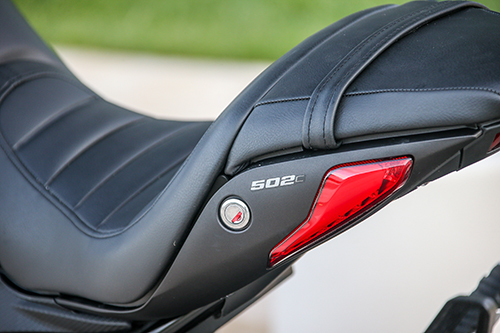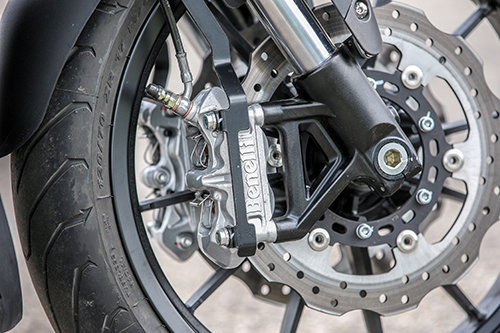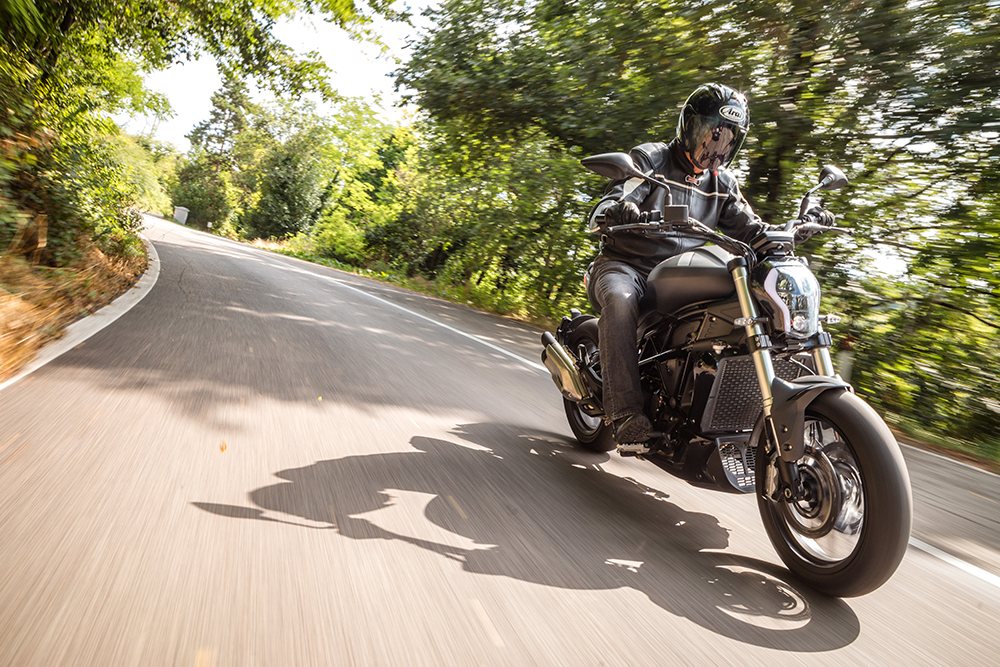Imitation may be the sincerest form of flattery, but it’s a commercially successful strategy, too, it turns out
Guess what? Benelli’s long-legged TRK 502 was Italy’s fourth most popular motorcycle of any kind in the first six months of 2019, behind the BMW R 1250 GS, Honda Africa Twin and – by just 11 units – the Yamaha Tracer 900.
Now, much in the same way as the TRK resembled Ducati’s Multistrada, the firm has introduced its first-ever cruiser, the 502 C, whose short-assed styling unashamedly resembles Ducati’s best-selling Diavel V-twin. It’s powered by the same 500cc parallel-twin eight-valve engine as the TRK, however, and as such it represents a direct competitor to Harley-Davidson’s Indian-built Street 500 that’s topped the sales charts here in Oz and in other markets.
It’s a poignant rivalry in light of the recent revelation that America’s No.1 has commissioned Benelli QJ to collaborate in building a 338cc Harley-branded single for sale in its dealerships in China by the end of 2020 – and, doubtless, in other Asian markets as well as Western ones.
Developed in Italy by Benelli’s engineering team headed by R&D Manager Stefano Michelotti, but manufactured by QJ in its modern well-equipped factory in China, the 502 C has entered production in Euro 4-compliant mode, complete with switchable two-channel Bosch ABS, at the same ultra-competitive price of $9790 ride away. This includes LED lighting all ’round, including the aggressive-looking headlight, and the indicators that look like they’re straight out of the Rizoma catalogue. And the array of rear stop lights includes one in the rear of the seat that lights up the Benelli name.
In beginning work on developing the 502 C three years ago, rather than use the rolling chassis of the Leoncino introduced just a year ago, Michelotti took the earlier TRK 502 adventure tourer’s tubular-steel trellis frame, in which the parallel-twin engine is wrapped as a semi-stressed member, and completely modified the chassis geometry to deliver a much longer 1580mm wheelbase than the TRK’s 1520mm span. This was partially achieved by kicking out the non-adjustable 41mm upside-down fork offering a rangy 135mm of wheel travel to a 27.5º rake, two degrees more than on the TRK, with 108mm of trail. At the rear there’s a braced tubular-steel swingarm carrying a centrally positioned cantilever monoshock which has a stroke of 50mm, delivering 125mm of wheel travel, according to Michelotti, with no damping adjustment, just spring preload.
The entire suspension and brake packages are all made by QJ in China, same as the engine in its entirety, plus frame, wheels, bodywork and even the headlamps.
“Unlike Western manufacturers, which can turn to specialists for components, we have to make everything in-house because there’s no equivalent of the European supply industry in China,” says Benelli QJ’s CEO Ms.Yan Haimei.
“So before fitting upside down forks for the first time, we had to learn how to make them – and now we produce them in volume ourselves.”
Benelli’s positioning of the new model as a wannabe dark side sportcruiser rather than a stripped-down Chinese custom is confirmed by the sporty twin front 280mm discs gripped by four-piston radial calipers, with a 240mm rear and twin-piston caliper. For that reason, too, both wheels front and rear are cast aluminium 17-inchers shod with Pirelli Angel ST tyres.


It’s a pity however that Benelli’s designer Stefano Casanova missed a trick by opting for a relatively skinny 160/60 rear tyre on a 4.50in rim, when a 180-section one would have given this Diavel in disguise added visual presence, without adversely affecting handling.
Sliding aboard the 502C reveals a low 750mm seat, it has a spacious, accessible riding position, but taller riders won’t feel cramped, just very much a part of the bike, thus promoting confidence. But while really nicely shaped, with its pan cupping your posterior, the seat could do with some thicker padding – I had minor traces of numb bum syndrome after a three-hour stint riding the Benelli midi-cruiser. That’s thanks to the 502 C’s quite erect stance compared to its sister models, because you’re sitting much further back on it, with the footrests a massive 30cm further forward than on the TRK, according to Michelotti, and they’re also raised to prevent your boot heels grounding in turns. Which they will still do thanks to a mix of the excellent grip of the Pirelli rubber and the assured handling of the 502 C that’s definitely more sport than cruiser.
Carving corners along the switchback clifftop Strada Panoramica hugging the Adriatic coast between Benelli’s Pesaro base and the resort of Cattolica revealed a bike that’s both engaging to ride and improbably good-handling by cruiser standards. That’s despite the very relaxed riding position, with the 502C’s wide, pulled-back handlebar delivering that upright stance sweeping rearwards over the huge 21.5-litre fuel tank which dominates the styling, in net contrast to the smaller tank of, say, any Harley-Davidson Custom model. It’s even bigger than the TRK 502 adventure tourer’s 20-litre tank, so with Benellis’ claimed fuel consumption figure of 3.7L/100km, his should provide a range of 580km – that’s impressive, though I can’t help wondering how many owners will go touring on it, given the lack of mounting points for luggage, and that minuscule passenger pad?
The front brake lever is four-way adjustable, but not its counterpart working the light-action cable-operated clutch, whose progressive pickup makes the Benelli an easy ride for relative newbies and less experienced bikers. The mirrors are well designed and, besides looking good, give an excellent view behind you with no vibration.
But less satisfactory is the positioning of the very well designed and clearly laid-out digital dash, complete with a large gear selected reading above the even bigger digital speedo in the centre of the display, plus an analogue tacho and water temp, fuel gauge, clock, mileage and twin trips, plus an array of warning lights on either side. But it’s frustratingly impossible to read any part of the dash in direct sunlight – including the speed, which is a definite handicap in traffic camera-sated Italy!
You can’t tilt it to avoid the glare, like on Harley’s new LiveWire, but when QJ finally gets round to redressing this, as Stefano Michelotti promised they would a year ago after I made exactly the same complaint after riding the Leoncino, it’ll rival KTM’s class benchmark for completeness at this price level. But right now, it’s almost dangerous.
The engine measures 69 x 66.8 mm for a capacity of 499.77cc, and was the second in a range of three all-new twin-cylinder designs conceived back in 2012, with the smaller BN 302 family the first to reach production in 2015, with this one next, and the largest 750cc version first displayed at the 2017 EICMA Milan Show now on the cusp of appearing in showrooms before the end of this year in the 2020 model 752 S, according to Yan Haimei.

In 502 C form, it’s mechanically identical in every way to its sister bikes, with the same 360º crank format – so with both pistons rising and falling together, as on a classic era Norton or Triumph twin.
“In determining the layout of our twin-cylinder engines, we firstly had to decide between a V-twin and a parallel-twin,” says Michelotti. “We chose a parallel-twin layout to share crossover technology with the BN 600 R in-line four we’d already developed. But then we had to decide what crankshaft format to use – 180º or 270º or 360º. We chose a 360º layout as giving greater flexibility, better low-down performance and a more individual sound.”
That it does, for the 502C is in every way a modern take on what a traditional-style 500cc British parallel twin might be like today. That’s something the current Triumph Bonneville and especially the Royal Enfield 650 twins, which are right in the slightly less expensive Benelli’s sights, don’t provide with their 270º pseudo-V-twin crank throws – but the Benelli does.
The resultant short, compact wet-sump engine design is a good-looking motor, as demonstrated in the Leoncino where it’s in plain view. But that’s curiously not the case here on this cruiser where looks are everything, with the 502 C’s large fuel tank and various covers shrouding the cylinders, which are inclined forward by 20 degrees, sitting on a robust-looking crankcase, with the six-speed transmission’s oil-bath clutch mounted tightly to it.
The double overhead camshafts are chain-driven up the left side of the engine, with the paired 25mm inlet valves and 22mm exhausts set at a relatively flat 28.8° included angle. Compression ratio is 11.5:1, delivered via the three-ring cast pistons and a shallow combustion chamber. Peak power of 35kW (48hp) is delivered at 8500rpm, with 46Nm of torque at 6000 revs – exactly the same as on the TRK duo and the Leoncino. Yep, it’s learner legal.
With a cable throttle rather than ride by wire, there’s no choice of riding modes, nor any other electronic rider aides beyond the switchable Bosch ABS that’s required for Euro-4 compliance. Simple is best, is QJ’s mantra, and that’s quite acceptable at such an accessible price point. Fitted with twin lambda probe oxygen sensors attached to the dual catalyst-equipped Euro 4-legal exhaust system to optimise the fuelling controlled by the Bosch ECU, and with a single injector for each of the twin 37mm throttle bodies made in-house by QJ, the Benelli’s motor weighing 65kg without throttle bodies carries a single counterbalancer positioned in front of the crankshaft, and gear-driven off it.
Just as on the TRK and Leoncino, this results in a jewel of an engine that’s uncannily smooth once you thumb the starter and it booms immediately into life, settling to a high 1400rpm idle speed with that very individual audio soundtrack emanating from the 2-1-2 twin-exit exhaust running up the right side of the bike. Thanks to the balance shaft, there’s essentially no vibration in either seat, handlebar or footrests on the 502 C – just a few slight tingles above 7000rpm.
According to Michelotti, the only engine characteristics on the 502 C which differ to the Leoncino are the exhaust system, cam timing and the revised engine mapping, courtesy of the Bosch supplied ECU.
“The long (five-litre) airbox helps reduce noise for Euro 4, but also delivers better low down torque,” he explains. “Between 2000-7000rpm we have more on the 502 C than on the TRK, even if peak power is the same. With a longer exhaust pipe we also have a smoother delivery with a very flat torque curve, to help achieve which we also changed the camshaft timing a little, while retaining the same cam profiles. And finally, we changed the strategy of the fuel supply system, and this also allowed us to improve the fuel consumption.”
So even less need for that massive fuel tank – right, Stefano?!
This lusty engine’s both torquey and forgiving on the 502 C, with seemingly more midrange grunt than on the Leoncino. That’s welcome because of the cruiser’s hefty 220kg kerb weight with all liquids aboard [192kg, dry] including that heavy full fuel load, compared to the Leoncino’s 207kg [186kg, dry] with its 12.7-litre fuel tank. It pulls really strongly from just 2000rpm, yet with a smooth initial pickup from a closed throttle that is a model for other manufacturers to follow.


Indeed, the Benelli’s fuel mapping is literally flawless – when I think back to the jerky throttle response, layered power delivery and stepped torque curve of the first Chinese-built Benelli I sampled just over four years ago – the four-cylinder BN 600 naked roadster – it’s a significant achievement, although QJ did have a top teacher like Bosch China to work with in getting there!
So initial pickup on the 502 C is just as good as on the lighter Leoncino, with the same well-chosen and fairly closed-up gear ratios, with 100km/h in top gear calling for just 5500rpm, and a comfortable cruising speed of 120km/h delivered at just 6500rpm. At no stage in the rev range does it seem to struggle for breath thanks to the broad spread of torque, and this makes it less critical which gear ratio you throw at it via the once again extremely sweet-shifting Japanese-quality six-speed gearbox.
And all the time you’re aware of that invigorating, evocative and so-distinctive drone from the exhaust – there’s literally nothing else available today in terms of sound and feel like the Benelli parallel-twins. You ought never to trouble the 10,400rpm rev limiter in real-world riding, and I found shifting up at just 7000rpm in the gears allowed me to surf that lovely torque curve in relaxed mode – it seemed I was riding a bigger capacity bike than a 500cc twin. It’s a junior tractor worthy of comparison with a Moto Guzzi V50 of yesteryear – only with quite a bit more oomph.
A key factor in the enjoyment of riding the 502 C was the Benelli’s confident handling and well-chosen suspension settings, thanks to QJ continuing its steep learning curve in brake and suspension technology. Okay, the rear end seemed a little less compliant than on the Leoncino I rode last year, so it did skip a little over the worst of the bumps when cruising along the Cattolica promenade running alongside the Adriatic beaches, but not enough to deflect me from straightlining to the café I was heading for to meet up with my mates.
Those relatively conservative geometry numbers aimed at achieving custom cool looks also deliver extra stability on fast sweepers, without sacrificing much agility in tighter turns. And the 502 C’s twin 280mm floating front discs gripped by radial-mounted four-pot calipers all made in China by QJ, worked very well within the context of a laid-back bike like this.
Despite the mounting, the calipers don’t have a fierce initial bite, but are effective when they need to be without an excessively hard pull on the lever, and you can modulate the braking very well on the 502 C. The twin-piston caliper and 260mm disc at the rear were a little soft – since many cruiser riders tend to use the back brake hard at the expense of the front, I reckon Benelli QJ might need to pay some attention to this. But the Pirelli Angel ST tyres fitted to the good-looking QJ-made cast aluminium wheels, a 120/70ZR17 on the 3.5-inch wide front, and 160/60ZR17 on the 4.5-inch rear delivered a comforting degree of grip on the uneven surfaces.
Build quality on the 502 C seemed pretty high for a bike in this price sector – once again, the whole finish is very good, fully on a level with anything made in Europe. This doesn’t look like a cost-cutting motorcycle in terms of manufacturing excellence – but the true test will come in terms of durability, and how well it shrugs off the wear and tear of everyday riding.
But it does seem that QJ has raised its game to match the quality of Western companies’ products, and the Benelli 502 C is a lot of motorcycle for the money.
